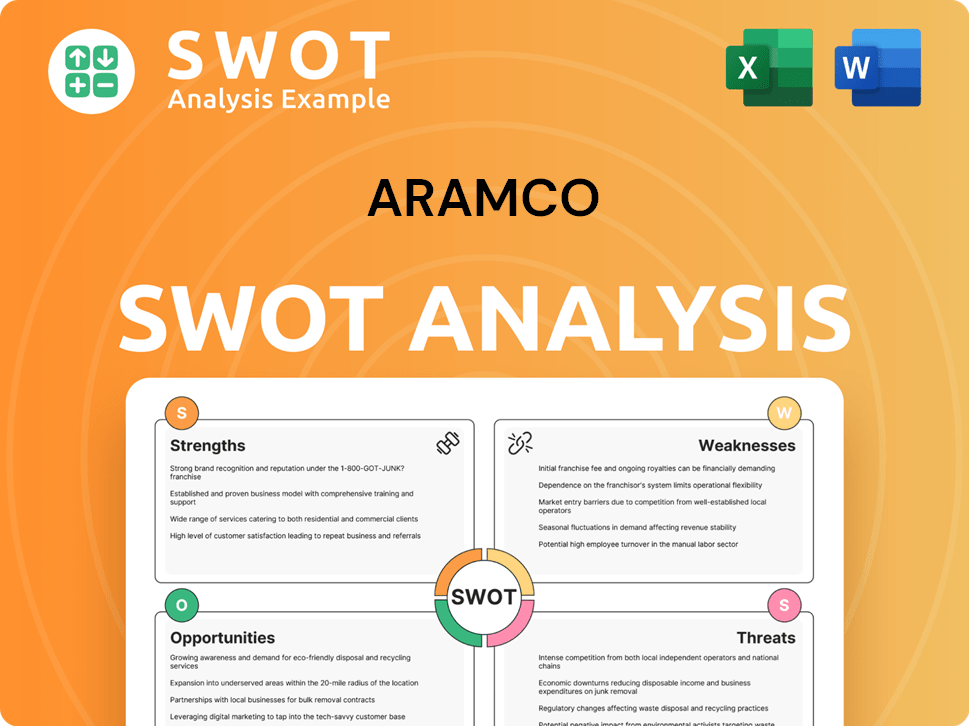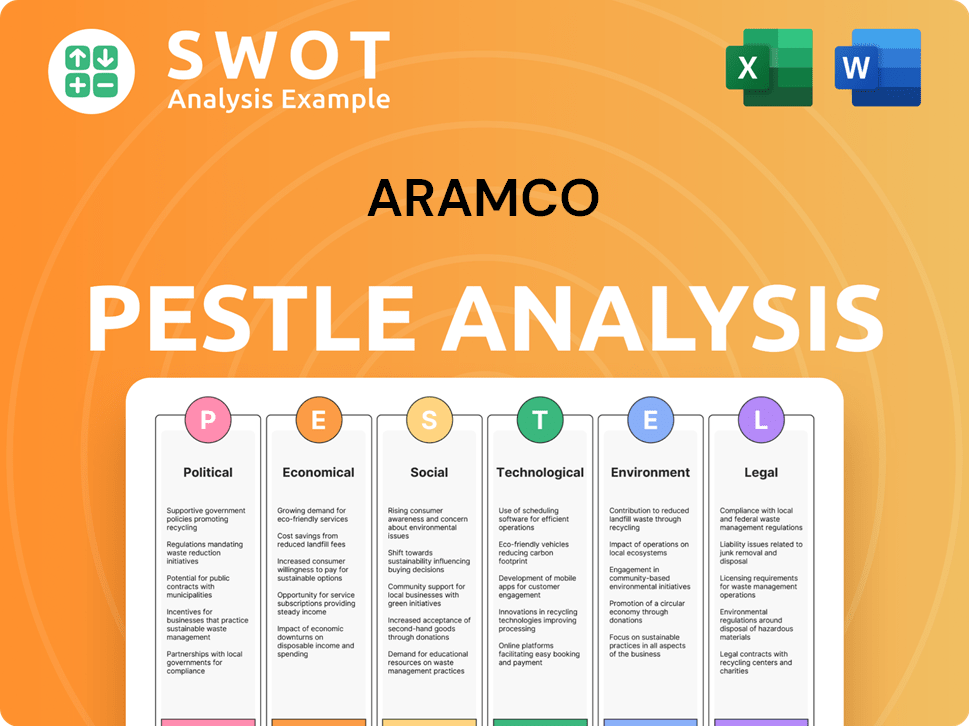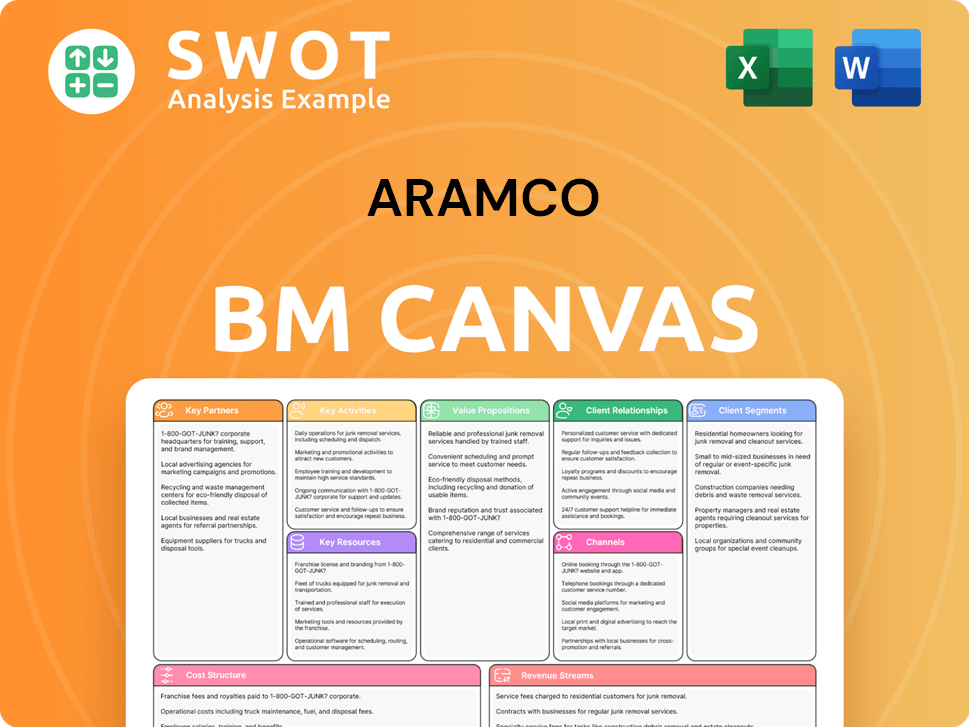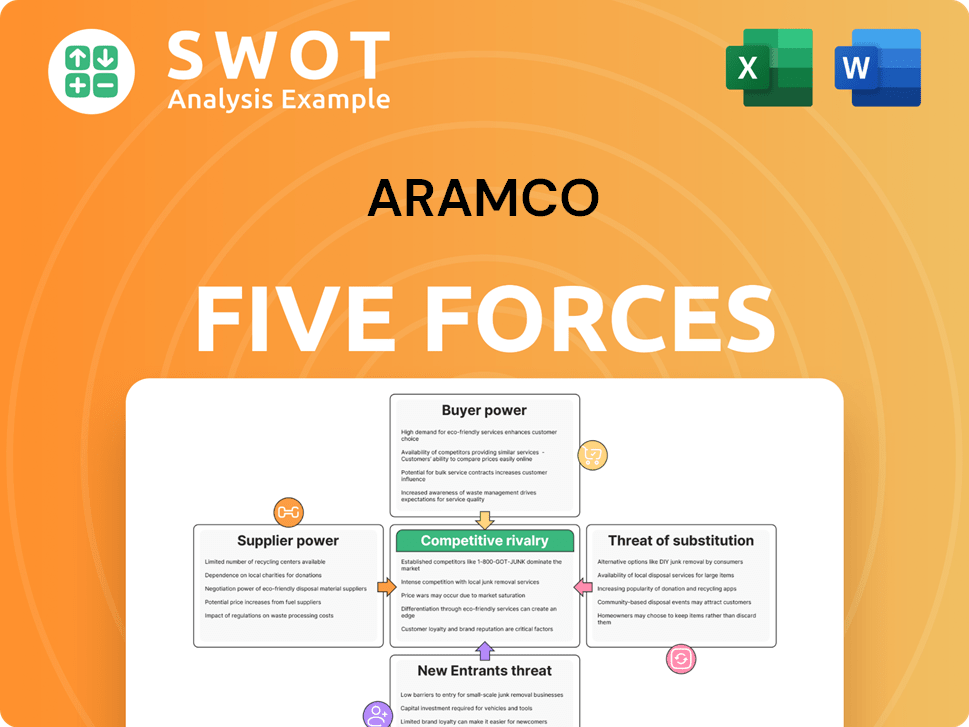Aramco Bundle
How Does Saudi Aramco Dominate the Energy Market?
Aramco's strategic shift towards downstream integration and global retail expansion marks a pivotal evolution in the energy sector. This transformation, especially pronounced in 2024 and 2025, signifies a deliberate move to capture greater value and diversify revenue streams beyond its traditional upstream focus. Understanding Aramco's Aramco SWOT Analysis is key to grasping its market dominance.

This article unravels Aramco's intricate Aramco sales strategy and Aramco marketing strategy, exploring its journey from a B2B crude oil supplier to a consumer-facing retail giant. We'll dissect its Aramco marketing and sales approaches, examining how it navigates the evolving energy landscape, builds customer relationships, and strategically positions its brand. Furthermore, we will conduct an Aramco market analysis to understand its competitive advantages and future plans.
How Does Aramco Reach Its Customers?
The sales channels of Aramco, a leading global energy and chemicals company, are multifaceted, reflecting its diverse product portfolio and global reach. The company's Aramco sales strategy historically centered on direct sales to international refiners and large industrial customers for crude oil and natural gas. This approach is supported by an extensive distribution network, including pipelines, terminals, and bulk plants.
Over recent years, Aramco marketing and sales strategies have evolved, particularly in the downstream sector. This evolution includes a growing presence in global fuel retailing and strategic acquisitions to expand its market footprint. These shifts aim to diversify revenue streams and enhance brand visibility beyond traditional B2B operations. For a deeper understanding of the company's overall strategy, consider exploring the Growth Strategy of Aramco.
Aramco's marketing strategy also involves leveraging a global network for its chemicals business, including joint ventures with industry leaders. This network facilitates the distribution and sale of a wide range of chemical products, optimizing product range and supply chain efficiency. The integration of SABIC, following its 70% acquisition in June 2020, has further streamlined marketing and sales efforts.
Aramco's primary sales channel involves direct transactions with international refiners and major industrial clients. This channel is crucial for the distribution of crude oil and natural gas. The company's extensive global distribution network, including pipelines, bulk plants, and terminals, supports these sales.
Aramco is actively expanding its presence in the fuel retail sector, particularly through acquisitions and partnerships. In May 2024, the company began converting 300 Petrobras service stations in Chile to its brand. Also, in May 2024, Aramco acquired a 40% stake in Gas & Oil Pakistan Ltd. (GO), which operates over 1,200 retail fuel stations.
The chemicals business utilizes a global network of joint ventures to distribute and sell its products. These partnerships with industry leaders like DowDuPont (Sadara), ExxonMobil (SAMREF), and Sinopec (Yasref) are essential for market reach. This network enables efficient distribution and sales of a wide range of chemical products.
Following the acquisition of SABIC, Aramco has focused on integrating marketing and sales efforts. SABIC concentrates on petrochemicals, while Aramco Trading Company (ATC) handles fuel products. This integration optimizes product range and supply chain efficiency, enhancing overall market performance.
Aramco's sales strategy is designed to leverage multiple channels for maximum market penetration and revenue generation. The company focuses on direct sales to large customers and strategic expansion into retail markets. This approach is supported by a robust distribution network and strategic partnerships.
- Direct sales to international refiners and industrial customers remain a core channel.
- Expansion into fuel retailing through acquisitions and conversions.
- Leveraging a global network for the chemicals business through joint ventures.
- Integration of SABIC to optimize product range and supply chain efficiency.
Aramco SWOT Analysis
- Complete SWOT Breakdown
- Fully Customizable
- Editable in Excel & Word
- Professional Formatting
- Investor-Ready Format

What Marketing Tactics Does Aramco Use?
The marketing tactics of Aramco are multifaceted, designed to address both its business-to-business (B2B) and emerging business-to-consumer (B2C) segments effectively. The company leverages a combination of traditional and digital strategies to build brand awareness, generate leads, and drive sales across its diverse operations.
For its core energy business, Aramco focuses on corporate communications, industry events, and direct engagement with key stakeholders. This approach emphasizes operational excellence, reliability, and its critical role in global energy security. In the digital realm, Aramco uses its website and social media to disseminate news, highlight technological advancements, and showcase sustainability efforts.
In its retail fuel operations, Aramco is likely to adopt more conventional and digital B2C marketing tactics. This includes local advertising, loyalty programs, and social media engagement tailored to consumer audiences. Data-driven marketing and customer segmentation are crucial for understanding consumer behavior and tailoring offerings effectively.
Aramco's B2B marketing strategy centers on corporate communications and direct engagement. Key stakeholders are targeted through industry events and showcasing operational excellence. This approach reinforces Aramco's position in the global energy market.
The company uses its official website and social media platforms to share news and technological advancements. Sustainability initiatives are also highlighted, aligning with global environmental goals. This digital presence supports the overall Aramco marketing strategy.
For retail fuel, Aramco likely uses traditional and digital B2C marketing tactics. This includes local advertising, loyalty programs, and social media engagement. Data-driven marketing is critical for understanding consumer behavior.
Aramco's commitment to sustainability and net-zero emissions by 2060 is a key marketing differentiator. This aligns with global environmental goals, attracting environmentally conscious consumers and investors. This commitment is a core part of the Aramco marketing and sales approach.
Participation in major industry forums like ADIPEC and EGYPES is a key marketing platform. These events provide networking opportunities and showcase Aramco's latest developments. These events help strengthen the Aramco sales strategy.
Content marketing and industry partnerships are used to promote research and development in emerging energy sectors. This includes areas like digitalization and advanced materials. This approach helps to inform and engage stakeholders.
Aramco's marketing strategy is also influenced by its commitment to sustainability, which is a significant differentiator in the global market. The company's approach to achieving net-zero emissions by 2060 is a key marketing message, aligning with global environmental goals and attracting environmentally conscious consumers and investors. For a deeper understanding of the company's financial structure, consider exploring the Revenue Streams & Business Model of Aramco.
Aramco employs a multifaceted approach to marketing, adapting to both B2B and B2C segments. The company focuses on several key areas to build awareness and drive sales.
- Corporate Communications: Used to build brand awareness and engage key stakeholders.
- Industry Events: Participation in events like ADIPEC and EGYPES for networking and showcasing advancements.
- Digital Marketing: Utilization of the official website and social media to disseminate news and highlight sustainability initiatives.
- B2C Marketing: Adoption of traditional and digital tactics for retail fuel operations, including local advertising and loyalty programs.
- Sustainability Focus: Promoting the commitment to net-zero emissions by 2060 as a key marketing differentiator.
- Data-Driven Marketing: Employing customer segmentation to understand consumer behavior and tailor offerings.
Aramco PESTLE Analysis
- Covers All 6 PESTLE Categories
- No Research Needed – Save Hours of Work
- Built by Experts, Trusted by Consultants
- Instant Download, Ready to Use
- 100% Editable, Fully Customizable

How Is Aramco Positioned in the Market?
Aramco's brand positioning centers on its identity as a leading global integrated energy and chemicals company. It emphasizes reliability, scale, and a commitment to innovation and sustainability, aiming to provide dependable energy while transitioning towards a lower-carbon future. The company's visual identity, often featuring a distinctive 10-pointed star logo, conveys technological precision and energy.
The core message of Aramco revolves around providing dependable energy to the world while increasingly focusing on a lower-carbon future. The company's blue and green color scheme symbolizes professionalism, nature, and resource wealth. This positioning is crucial for its Aramco sales strategy and Aramco marketing strategy, which must resonate with a diverse global audience.
Aramco differentiates itself from competitors through its unique scale of operations and low production costs. While traditionally focused on a B2B audience, it's broadening its appeal through diversification into chemicals and retail. Its brand positioning is evolving to incorporate themes of sustainability and its contribution to the global energy transition. For more insights, consider reading about the Target Market of Aramco.
Aramco's vast scale of operations and low production costs are key differentiators. This allows for competitive pricing strategies in the global market. This is a crucial aspect of its Aramco business model.
The company is actively communicating its sustainability initiatives and investments in new energy solutions. This includes hydrogen and carbon capture technologies. This is part of its Aramco marketing and sales efforts to appeal to a broader audience.
Despite being the Middle East's most valuable brand, with a brand value of USD 41.6 billion in April 2024, Aramco faces challenges. These challenges are particularly in B2C customer favorability.
Aramco aims to achieve net-zero carbon emissions from its wholly-owned operations by 2060. This is a significant part of its long-term strategy. This impacts its Aramco market analysis and future plans.
Aramco's strategies focus on maintaining a strong brand image and adapting to consumer sentiment shifts. This involves consistent communication and investment in new energy solutions. The company's approach is crucial for its Aramco's sales strategy for crude oil and overall market presence.
- Emphasis on reliability and scale.
- Focus on sustainability and lower-carbon future.
- Diversification into chemicals and retail.
- Active communication of sustainability initiatives.
Aramco Business Model Canvas
- Complete 9-Block Business Model Canvas
- Effortlessly Communicate Your Business Strategy
- Investor-Ready BMC Format
- 100% Editable and Customizable
- Clear and Structured Layout

What Are Aramco’s Most Notable Campaigns?
Understanding the key campaigns of Saudi Aramco (Aramco) provides insight into its Aramco sales strategy and Aramco marketing strategy. While not always traditional advertising-led, these initiatives are crucial for building brand recognition, diversifying revenue streams, and positioning the company in a changing global energy landscape. The focus is on strategic investments and communications that align with long-term business goals.
Aramco's marketing and sales efforts are often centered around corporate communications and strategic partnerships. The company's approach involves significant investments in acquisitions, sustainability initiatives, and global partnerships to enhance its market presence and strengthen its brand image. This approach is designed to support its overall business objectives.
Aramco market analysis reveals a strategic shift towards downstream operations and sustainability. These moves are designed to build a more resilient business model and engage stakeholders concerned about climate change. These efforts are part of Aramco's broader plans for the future.
Aramco is expanding its retail fuel presence globally. This includes converting service stations and acquiring stakes in existing networks. For instance, the gradual conversion of 300 Petrobras service stations in Chile to Aramco stations began in May 2024. This strategic move aims to diversify the company's downstream portfolio.
Aramco is committed to achieving net-zero carbon emissions by 2060. The company’s 2024 Sustainability Report, published in May 2025, outlines its interim target for 2030 to reduce carbon intensity. These efforts include investments in carbon capture and storage projects.
Aramco's global partnership with Formula One, announced in March 2020, is a key branding campaign. This sponsorship helps to enhance international presence and associate the brand with advanced technology. The high-profile nature of motorsports boosts brand visibility.
Aramco's 40% stake in Gas & Oil Pakistan Ltd. (GO), with its network of over 1,200 retail fuel stations, acquired in May 2024, is a strategic move. These partnerships are crucial for expanding market reach and building direct brand recognition. This expansion is a key element of Aramco's strategy.
Aramco's campaigns focus on several key objectives. These include diversifying its downstream portfolio and building brand recognition. Another major goal is to highlight its commitment to sustainability and the energy transition. These are all part of the company's long-term Aramco business model.
- Expansion of retail fuel networks.
- Investment in lower-carbon solutions.
- Strengthening global brand visibility through partnerships.
- Focus on communicating sustainability efforts.
For more information about the structure of Aramco, you can read about the Owners & Shareholders of Aramco.
Aramco Porter's Five Forces Analysis
- Covers All 5 Competitive Forces in Detail
- Structured for Consultants, Students, and Founders
- 100% Editable in Microsoft Word & Excel
- Instant Digital Download – Use Immediately
- Compatible with Mac & PC – Fully Unlocked

Related Blogs
- What are Mission Vision & Core Values of Aramco Company?
- What is Competitive Landscape of Aramco Company?
- What is Growth Strategy and Future Prospects of Aramco Company?
- How Does Aramco Company Work?
- What is Brief History of Aramco Company?
- Who Owns Aramco Company?
- What is Customer Demographics and Target Market of Aramco Company?
Disclaimer
All information, articles, and product details provided on this website are for general informational and educational purposes only. We do not claim any ownership over, nor do we intend to infringe upon, any trademarks, copyrights, logos, brand names, or other intellectual property mentioned or depicted on this site. Such intellectual property remains the property of its respective owners, and any references here are made solely for identification or informational purposes, without implying any affiliation, endorsement, or partnership.
We make no representations or warranties, express or implied, regarding the accuracy, completeness, or suitability of any content or products presented. Nothing on this website should be construed as legal, tax, investment, financial, medical, or other professional advice. In addition, no part of this site—including articles or product references—constitutes a solicitation, recommendation, endorsement, advertisement, or offer to buy or sell any securities, franchises, or other financial instruments, particularly in jurisdictions where such activity would be unlawful.
All content is of a general nature and may not address the specific circumstances of any individual or entity. It is not a substitute for professional advice or services. Any actions you take based on the information provided here are strictly at your own risk. You accept full responsibility for any decisions or outcomes arising from your use of this website and agree to release us from any liability in connection with your use of, or reliance upon, the content or products found herein.